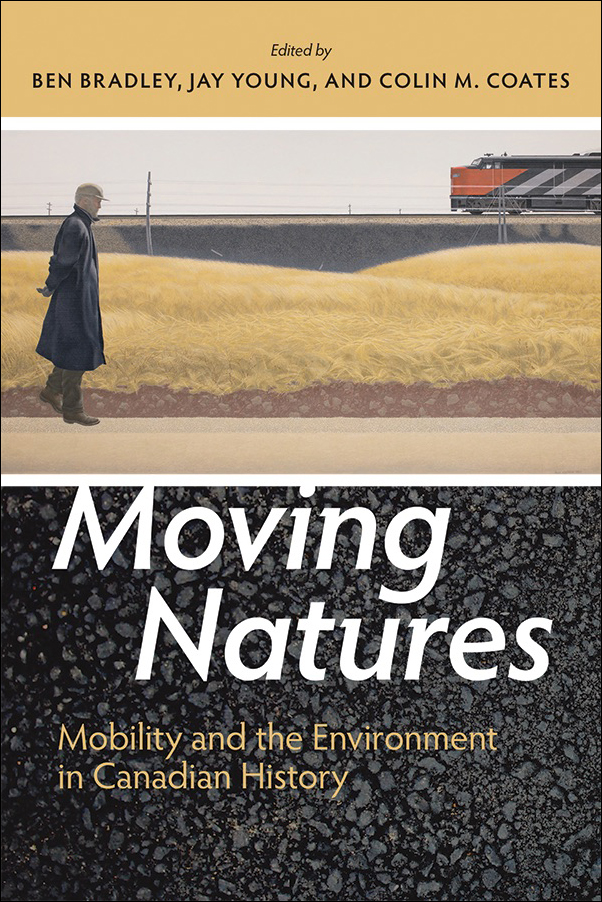
Moving Natures: Mobility and the Environment in Canadian History
Edited by Ben Bradley, Jay Young, and Colin M. Coates
$34.95 CAD / $34.95 USD (S)
352 pages, notes, bibliography, index
25 b&w and 13 colour illustrations, 9 maps, 2 tables
Paperback: 978-1-55238-859-4
Epub: 978-1-55238-862-4
Library PDF: 978-1-55238-861-7
June 2016
Mobility – the movements of people, things, and ideas, as well as their associated cultural meanings – has been a key factor in shaping Canadians’ perceptions of and interactions with their country. Approaching the burgeoning field of environmental history in Canada through the lens of mobility reveals some of the distinctive ways in which Canadians have come to terms with the country’s climate and landscape.
Spanning Canada’s diverse regions, throughout its history, from the closing of the age of sail to the contemporary era of just-on-time delivery, Moving Natures: Mobility and the Environment in Canadian History examines a wide range of topics, from the impact of seasonal climactic conditions on different transportation modes, to the environmental consequences of building mobility corridors and pathways, to the relationship between changing forms of mobility with tourism and other recreational activities. Contributors make use of traditional archival sources, as well as historical geographic information systems (HGIS), qualitative and quantitative analysis, and critical theory.
This thought-provoking collection divides the intersection of environmental and mobility history into two approaches. The chapters in the first section deal primarily with the construction and productive use of mobility technologies and infrastructure, as well as their environmental constraints and consequences. The chapters in the second section focus on consumers’ uses of those vehicles and pathways: on pleasure travel, tourism, and recreational mobility. Together, they highlight three quintessentially Canadian themes: seasonality, links between mobility and natural resource development, and urbanites’ experiences of the environment through mobility.
With Contributions By: Judy Burns, Jim Clifford, Ken Cruikshank, Jessica Dunkin, Elizabeth L. Jewett, Don Lafreniere, Elsa Lam, Maude-Emmanuelle Lambert, J.I. Little, Daniel Macfarlane, Merle Massie, Tor H. Oiamo, Joy Parr, Thomas Peace, and Andrew Watson
Ben Bradley is a Grant Notley Postdoctoral Fellow in the Department of History and Classics at the University of Alberta. His research examines the linkages between mobility, landscape, and mass culture in twentieth-century Canada.
Jay Young is outreach officer at the Archives of Ontario and a founding editor of ActiveHistory.ca. He completed his doctorate at York University in 2012 followed by a SSHRC postdoctoral fellowship in history at McMaster University.
Colin M. Coates teaches environmental history and Canadian studies at York University. He is past president of the Canadian Studies Network–Réseau d’études canadiennes and was a member of the executive of NiCHE, the Network in Canadian History and Environment.
Illustrations
Acknowledgments
Moving Natures in Canadian History: An Introduction
Jay Young, Ben Bradley, and Colin M. Coates
Part 1: Production, Pathways, and Supply
Maitland’s Moment: Turning Nova Scotia’s Forests into Ships for the Global Commodity Trade in the Mid-Nineteenth Century
Thomas Peace, Jim Clifford, and Judy Burns
Forest, Stream and . . . Snowstorms? Seasonality, Nature, and Mobility on the Intercolonial Railway, 1876-1914
Ken Cruikshank
Supply Networks in the Age of Steamboat Navigation: Lakeside Mobility in Muskoka, Ontario, 1880-1930
Andrew Watson
Seasonality and Mobility in Northern Saskatchewan, 1890-1950
Merle Massie
Creating the St. Lawrence Seaway: Mobility and a Modern Megaproject
Daniel Macfarlane
Soils and Subways: Excavating Environments during the Building of Rapid Transit in Toronto, 1944-1968
Jay Young
The Windsor-Detroit Borderland: The making of a Key North American Environment of Mobility
Tor H. Oiamo, Don Lafreniere, and Jay Parr
Part II: Consumption, Landscape, and Leisure
Views from the Deck: Union Steamship Cruises on Canada’s Pacific Coast, 1889-1958
J.I. Little
Producing and Consuming Spaces of Sport and Leisure: The Encampments and Regattas of the American Canoe Association, 1880-1930
Jessica Dunkin
What was Driving Golf? Mobility, Nature, and the Making of Canadian Leisure Landscapes, 1870-1930
Elizabeth L. Jewett
Rails, Trails, Roads and Lodgings: The Networks of Mibility and the Touristic Development of "The Canadian Pacific Rockies," 1885-1930
Elsa Lam
Automobile Tourism in Quebec and Ontario: Development, Promotion, and Representation, 1920-1945
Maude-Emmanuelle Lambert
Contributors
Index
Moving Natures presents an engaging and thought-provoking introduction to the potential of reimagining the interconnected roles of mobility and the environment in Canadian History
—J.L. Weller, BC Studies
This excellent collection should be seen as an initial step towards the refinement of mobility as a historical concept and a greater unpacking of mobility histories.
—Alan Gordan, The Journal of Transport History
[This] is a welcome intervention in several fields that engage with Canada’s size, including environmental history, mobility studies, science and technology studies, and Canadian social and cultural history. Here, dominant narratives of transportation networks as annihilators of Canadian distances are complicated and decentralized by prying open the black boxes of mobility studies and environmental history with the crowbars of the other . . . The result is a well-rounded set of twelve interdisciplinary stories that address both the impact of mobility networks on the environment as well as changing perceptions of the environment when viewed from different transportation platforms.
—Blair Stein, Scientia Canadensis
This collection puts older themes in a new light, works outside of a nationalist perspective, and offers close readings of cases to make larger observations . . . Many historical geographers and environmental historians will find a great deal of interest within these pages, and the basis for fruitful comparisons with other cases and places.
—Matthew Evenden, Journal of Historical Geography
4. Seasonality and Mobility in Northern Saskatchewan, 1890–1950
5. Creating the St. Lawrence Seaway: Mobility and a Modern Megaproject
7. The Windsor-Detroit Borderland: The Making of a Key North American Environment of Mobility
8. Views from the Deck: Union Steamship Cruises on Canada’s Pacific Coast, 1889–1958
12. Automobile Tourism in Quebec and Ontario: Development, Promotion, and Representations, 1920–1945
WINNER, Heritage Toronto Historical Writing: Short Publications Award for the chapter "Soils and Subways: Excavating Environments during the Building of Rapid Transit in Toronto, 1944-1968" by Jay Young | 2017